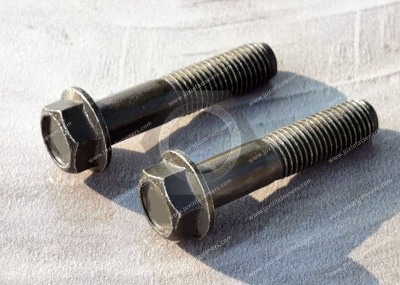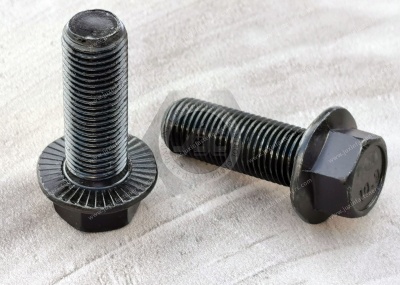Call Us
+86 136 6007 9809
Call Us
+86 136 6007 9809
Jun. 29, 2024
Hexagonal Flange Screws Fastening Methods and Requirements Industry Solutions
What is a hexagonal flange screw?
Flange screws, mainly by the hex head and flange (hex below the gasket and hex fixed together) and screw (with external threads of the cylinder), two parts of a class of fasteners, need to cooperate with the nut, used to fasten the connection of two parts with a through hole.
This form of connection is called a bolt connection. If the nut from the bolt is down, you can separate the two parts, making the connection removable.
Flange bolts are standard fasteners. They are widely used in highway and railroad bridges, industrial and civil construction, cranes, excavators, and other heavy machinery. The scope of the application is extensive.
Hexagonal flange screws classification.
1. Hexagonal flange type: There are two kinds of hexagonal heads: one has a flat brain, and another has a concave brain.
2. Surface color categories: according to different needs, the surface has white plating, military green, color yellow, and another never rust Dacromet.
3. Flange category: according to the use of flange screws in different places, the size of the disk requirements are different; there are flat bottoms and the teeth of the points, with the teeth of the anti-slip effect.
4. According to the connection of the force, there are ordinary and reamed holes. Flange screws for reamed holes should be matched with the size of the holes and used when subjected to lateral force. In addition, holes in the rod can prevent the bolt vibration from coming loose to meet the locking needs after installation. Some flange bolts are not threaded rods to do thin, so they are called thin rod flange bolts. This kind of flange bolt is favorable to the connection of variable force. There are special high-strength bolts on the steel structure. The head will be made more prominent. There are also changes in size.
Standard materials of hexagonal flange screws.
1. High carbon steel C%> 0.45%. Hexagonal flange surface screws product materials currently on the market did not use;
2. Medium carbon steel 0.25% hexagon head screws in the carbon steel material are usually called domestic No. 35, No. 45 steel, foreign essential known as 1035, CH38F, 1039, 40ACR, and so on and are mainly used for grade 8 nuts, 8.8 bolts, and 8.8 hexagonal products.
3.low carbon steel C% ≤ 0.25% domestic usually called A3 steel. Overseas, known as 1008, 1015, 1018, 1022, etc.. Mainly used for 4.8-grade bolts and 4-grade nuts, small screws, and other products without hardness requirements. (Note: Drill nails mainly with 1022 material.)
4. Alloy steel: In plain carbon steel, alloying elements are added to increase some of the steel's unique properties, such as 35, 40 chromium molybdenum, SCM435, and 10B38. Hexagonal flange bolts mainly use SCM435 chromium molybdenum alloy steel, the main components of which are C, Si, Mn, P, S, Cr, and Mo.
High-Strength Metric Class 10.9 Steel Flanged Hex Head Screws: Choose these Class 10.9 steel screws for high-stress applications, such as valves, pumps, motors, and automotive suspension systems. They are at least 25% stronger than medium-strength steel screws. The flange distributes pressure where the screw meets the surface, eliminating the need for a separate washer. Head height includes the flange. Length is measured from under the flange.
Black-phosphate steel screws are mildly corrosion-resistant in dry environments. Zinc yellow-chromate plated steel screws resist corrosion in wet environments.
Screws that meet ISO 898-1 or SAE J1199 comply with specifications and testing requirements for material quality. Screws that meet ASME B18.2.3.9M or DIN 6921 comply with specifications for dimensional standards.
High-Strength Grade 8 Steel Flanged Hex Head Screws: Made from Grade 8 steel, these screws can be used in high-stress applications, such as valves, pumps, motors, and automotive suspension systems. They are at least 25% stronger than medium-strength steel screws. The flange distributes pressure where the screw meets the surface, eliminating the need for a separate washer. The material meets SAE J429 specifications for quality. Dimensions meet IFI 111 specifications. Grade 8 steel hex head screws are marked with six radial lines. Head height includes the flange. Length is measured from under the flange.
Black-phosphate steel screws are mildly corrosion-resistant in dry environments. Zinc yellow-chromate plated steel screws resist corrosion in wet environments.
Match the thread spacing of mating components. Coarse threads are the industry standard; choose these screws if you don’t know the threads per inch. Fine threads are closely spaced to prevent loosening from vibration.
Stainless Steel Flanged Hex Head Screws: Made from 18-8 stainless steel, these screws have good chemical resistance and may be mildly magnetic. The flange distributes pressure where the screw meets the surface, eliminating the need for a separate washer. Head height includes the flange. Length is measured from under the flange.
Inch screws meet ASTM F593 material quality standards and IFI 111 dimensional standards.
Metric screws meet DIN 6921 dimensional standards.
For high-quality Carbon Steel Hexagonal Head Screws&hex nuts and professional technical support, don't hesitate to contact us at adelajonly@gmail.com or visit our website at: https://www.juxinfasteners.com.


Hexagonal flange screw fastening methods and requirements
(1) No torque plum wrench or whacking wrench.
Applicable to general equipment and pipeline flange fastening, according to the screw size and flange pressure level selection. Fastening requirements are as follows.
1) Maintenance unit to develop a fastening program, symmetrical fastening of flanges, fastening sequence numbering, refer to Figure 1, Figure 2 numbering.
2) Position the gasket with four screws at positions 1, 2, 3, and 4 to ensure that the center of the wrapped gasket is within the edge of the flange.
3) Hand-tighten the fixing screws, then insert the other stud screws and pull them to balance the load; make sure that at least two threads are exposed at each end of the nut.
4) According to the field equipment and flange, according to fastening a circle for a calculation, the reasonable development of the number of fastening (at least three times) and each time the fastening of the pounding load (strength), fastening pounding load (strength) according to the smallest to the largest sequential fastening (such as 50%, 80%, 100% incremental), can not be loaded with too fast and too large, to prevent the gasket sealing failure.
5) The sequence of each tightening with a torque-free wrench or whacking wrench.
A, fastening radially opposite two screws to the screws of the established hammer load (strength)
b, tighten and the previous two screws along the circumference of the other pair of screws about 90 degrees apart; c, continue to tighten until all the remaining screws.
c. Continue tightening until all remaining screws are tightened to the established hammering load.
6 ) Finally, according to the 100% hammer load (strength) will be all the screws in the clockwise or counterclockwise direction to tighten once.
(2) Torque wrench.
Applicable to high temperature and pressure, flammable and explosive, and other necessary equipment and pipeline flange. Fastening requirements are as follows.
1) Maintenance units need to develop a fastening program, create the appropriate torque, and according to the strength of the screws, gasket initial sealing pressure and working sealing pressure, medium pressure, and other parameters of the design review, to prevent the screws from breaking and the gasket due to the pressure is too large to lose elasticity and lead to sealing failure.
2) The flange according to symmetrical fastening, fastening sequence number, refer to Figure 1, Figure 2 number.
3) Position the gasket with four screws at 1, 2, 3, and 4 to ensure that the center of the wound gasket is within the edge of the flange.
4) Tighten the fixing screws by hand, then insert the other stud screws and tighten them to make the load balanced, making sure that at least two threads are exposed at each end of the nut.
5) According to the site equipment and flange, according to fastening a circle for a calculation, reasonable development of the number of fastening (at least three times) and each fastening torque, fastening torque from small to large sequential fastening (such as 50%, 80%, 100% incremental), can not be loaded too fast and too large, to prevent gasket sealing failure.
6) Torque wrench each time the order of fastening.
a. tighten the radial relative to the two screws to the screw's established torque.
b, tighten and the previous two screws along the circumference of the other pair of screws about 90 degrees apart; c, continue to tighten until all the rest of the screws.
c. Continue tightening until all remaining screws are tightened to the established torque.
7) Finally, tighten all screws in the clockwise or counterclockwise direction according to 100% torque value.
8) Record the torque value for future maintenance reference.
(3) Screw tensioner: It is suitable for high temperature and high pressure, flammable and explosive, and other necessary equipment and pipeline flange. Fastening requirements are as follows.
(1) maintenance unit to develop a fastening program, the development of appropriate tension, and according to the strength of the screws, gaskets, the initial sealing pressure and the work of the sealing pressure, medium pressure, and other parameters of the design review to prevent the screws from breaking and gaskets due to excessive pressure and loss of elasticity resulting in seal failure.
2) Screw tensioner single (step by step) stretch fastening screws, according to the principle of screw fastening uniformity, refer to the torque wrench fastening sequence stretching fastening.
3) Screw tensioner stretching and fastening process, the reasonable development of the number of stretching and fastening, pressurization from small to considerable sequential pressure (such as 50%, 80%, 100%), uniform pressure, every increase in a certain amount of pressure to stabilize the pressure and then raise, to avoid excessive impact on the tension, affecting the pre-tightening effect of the screws.
Contact Us
Tel.:
+86 020 8621 0320
+86 020 3121 6067
Technical Support:
Navigation
SEND INQUIREY